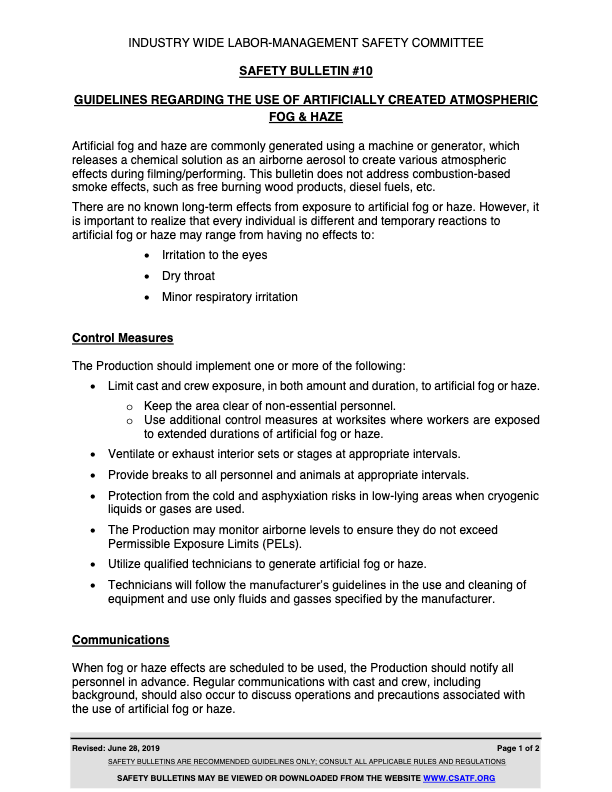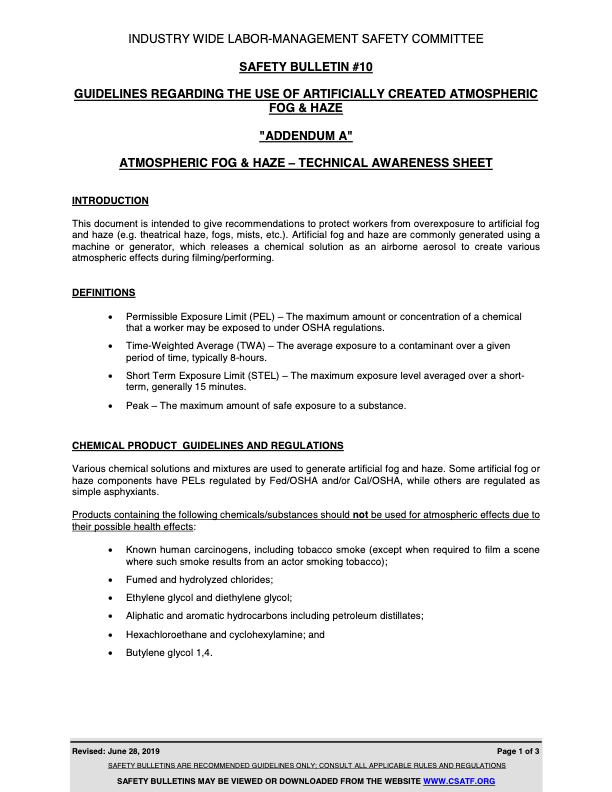Safety Bulletin

Guidelines
Artificial fog and haze are commonly generated using a machine or generator, which releases a chemical solution as an airborne aerosol to create various atmospheric effects during filming/performing. This bulletin does not address combustion-based smoke effects, such as free burning wood products, diesel fuels, etc.
There are no known long-term effects from exposure to artificial fog or haze. However, it is important to realize that every individual is different and temporary reactions to artificial fog or haze may range from having no effects to:
- Irritation to the eyes
- Dry throat
- Minor respiratory irritation
Control Measures
The Production should implement one or more of the following:
- Limit cast and crew exposure, in both amount and duration, to artificial fog or haze.
- Keep the area clear of non-essential personnel.
- Use additional control measures at worksites where workers are exposed to extended durations of artificial fog or haze.
- Ventilate or exhaust interior sets or stages at appropriate intervals.
- Provide breaks to all personnel and animals at appropriate intervals.
- Protection from the cold and asphyxiation risks in low-lying areas when cryogenic liquids or gases are used.
- The Production may monitor airborne levels to ensure they do not exceed Permissible Exposure Limits (PELs).
- Utilize qualified technicians to generate artificial fog or haze.
- Technicians will follow the manufacturer’s guidelines in the use and cleaning of equipment and use only fluids and gasses specified by the manufacturer.
Communications
When fog or haze effects are scheduled to be used, the Production should notify all personnel in advance. Regular communications with cast and crew, including background, should also occur to discuss operations and precautions associated with the use of artificial fog or haze.
The following methods may be used to notify the cast and crew when artificial fog or haze will be used:
- Notification on the Call Sheet
- Safety Data Sheets (SDSs)
- Should be available at the worksite
- A supervisor or another member of department leadership will help to locate a copy of the SDS.
- Safety Meetings
A safety meeting should be held by the First Assistant Director, and may include the Special Effects Coordinator or qualified technicians, and should address, but not be limited to, the following topics:
- When and where atmospheric effects will be used.
- Ways to limit one’s exposure to artificial fog or haze, and options to obtain adequate fresh air.
- Availability and use of respiratory protection if airborne levels are expected to exceed PELs.
- How to seek medical care
- Where to find the SDS
Individuals with Sensitivities
The elderly, children, and people with respiratory conditions or other ailments may have a higher sensitivity to artificial fog or haze. These persons should inform the Production of their sensitivity.
When there is an infant present at a Production using artificial fog or haze, steps should be taken to prevent the infant from being exposed. Please consult Safety Bulletin: Infant Actors.
For further information on how to protect workers from overexposure to airborne chemicals generated when using artificial fog or haze, please refer to Safety Bulletin: Artificial Fog and Haze – Technical Awareness.

